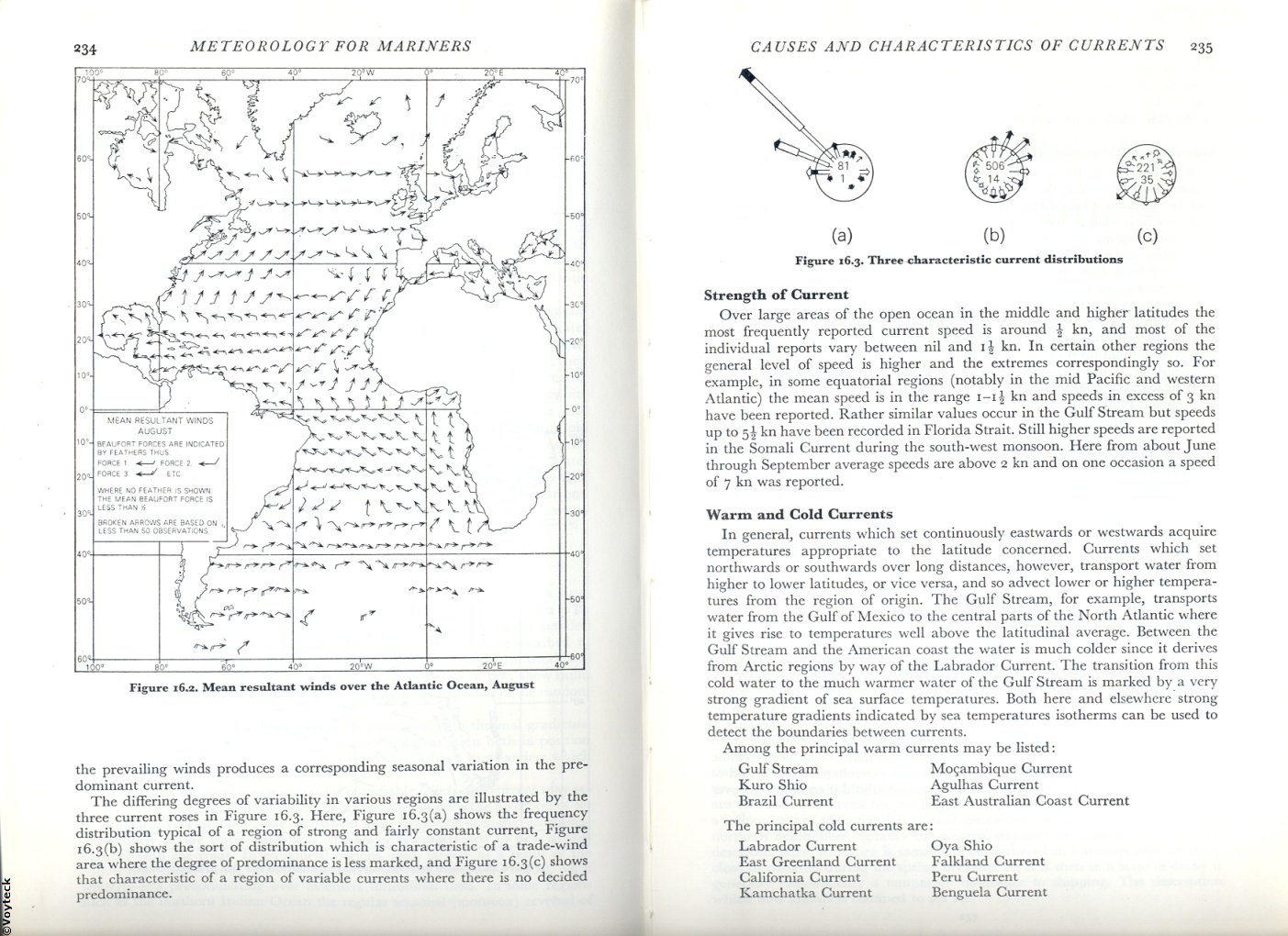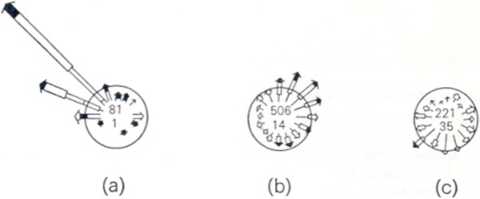234 235 (14)

234 METEOROLOG!' FOR MARINERS

Figurc 16.2. Mcan rcsultant winds ovcr the Atlantic Ocean, August
thc prevailing winds produces a corresponding seasonal variation in thc pre-dominant current.
The differing degrees of variability in various regions arc illustrated by the threc current roses in Figurę 16.3. Here, Figurę i6.3(a) shows thc frequcncy distribution typical of a region of strong and fairly constant current, Figurc i6-3(b) shows the sort of distribution which is characteristic of a trade-wind arca where the degrcc of prcdominance is less marked, and Figurę 16.3(0) shows that characteristic of a region of variable currcnts where there is no dcclded p redom i nancc.

Figurę 16.3. Three characteristic current distributions
Strength of Current
Over large arcas of the open ocean in the middlc and higher latitudes the most frequently reported current speed is around \ kn, and most of thc individual reports varv between nil and ij kn. In certain other regions the generał lcvel of speed is higher and the extremcs corrcspondingly so. For examplc, in some equatorial regions (notably in the mid Pacific and western Atlantic) the mcan speed is in the rangę 1-1J kn and speeds in cxccss of 3 kn have been reported. Rathcr similar valucs occur in thc Gulf Stream but speeds UP to 51 kn have been recorded in Florida Strait. Still higher speeds are reported in thc Somali Current during thc south-west monsoon. Herc from about June through Septcmbcr averagc speeds are abovc 2 kn and on one occasion a speed of 7 kn was reported.
Warm and Cold Currents
In generał, currents which set continuously eastwards or westwards acquirc temperatures appropriatc to the latitudc concerncd. Currents which set northwards or southwards ovcr long distanccs, however, transport water from higher to lower latitudes, or vice versa, and so advect lowcr or higher temperatures from thc region of origin. The Gulf Stream, for example, transports water from the Gulf of Mcxico to the central parts of thc North Atlantic where it gives risc to temperatures wcll abovc thc latitudinal avcrage. Between the Gulf Stream and the American coast the water is much coldcr sińce it dcrivcs from Arctic regions by way of thc Labrador Current. The transition from this cold water to the much warmer water of the Gulf Stream is marked by a vcry strong gradient of sca surfacc temperatures. Both here and elsewhere strong temperaturę gradients indicatcd by sea temperatures isotherms can be uscd to dctcct thc boundarics between currents.
Among the principal warm currents may be listed:
Gulf Stream Moęambique Current
Kuro Shio Agulhas Current
Brazil Current East Australian Coast Current
The principal cold currents are:
Labrador Current Oya Shio
East Greenland Current Falkland Current
California Current Peru Current
Kamchatka Current Bcnguela Current
Wyszukiwarka
Podobne podstrony:
242 243 (14) 242 METEOROLOGT FOR MARINERS salt is deposited, leaving purc icc containing pockets of
244 245 (14) 244 METEOROLOGT FOR MARINERS they reach an advanccd State of dccay, break into smali pi
230 231 (14) METEOROLOGY FOR MARINERS 230 hcmisphcrc) of that of the surfacc laycr. Thus, with incre
232 233 (14) METEOROLOG! FOR MARINERS 232 corresponding patterns of the prevailing winds. Figurę 16
224 225 (16) METEOROLOGY FOR MARINERS 224 Extreme Eastern Part of the Ocean The currents here, inclu
228 229 (15) 228 METEOROLOGT FOR MARINERS ARCTIC OCEAN The main inflow of water into the Arctic Basi
236 237 (13) METEOROLOGY FOR MARINERS 236 In thc casc of some of thc cold currents the Iow temperatu
238 239 (12) METEOROLOGY FOR MARINERS 238 Formation of Ice Fresh water and salt watcr do not frcczc
248 249 (13) METEOROLOG! FOR MARINERS 248 Antarctic Bcrgs The breaking away of ice from the Antarcti
254 255 (11) 254 METEOROLOGY FOR MARINERS SEA ICE IN THE SOUTHERN HEMISPHERE Though sca icc extends
256 257 (10) 256 METEOROLOGY FOR MARINERS Distribution of Sea Ice at the Time of G
264 265 (10) METEOROLOG! FOR MARINERS 264 speed at the locality in qucstion but also upon the diffe
266 267 (10) 266 METEOROLOG! FOR MARINERS An cfTcct which is sometimes ovcrlookcd is that of atmosp
Go >gle! 10 tttoht » ! Google Search Im bekng krcky Showng rezijti 1-10 of aporonmateh 234,000 fo
2vrc55qf22cpmf45q1s11145 iso chart 2 Table 2: Requirements for marinę residual fuels Characteristi
2vrc55qf22cpmf45q1s11145 ISO CHARTS1 Table 1: Reguirements for marinę distillate fuels Characteris
FUTURĘ PROSPECTS In 2020, the demand for marinę distillates may be as much as 200-250 million tonnes
IV Jesienne opowieści Tematy kolejnych dni 14. Wywiad z meteorologiem 15.
Kraków, luty 2013 Opracowanie: DELTA. 31-234 Kraków, ul. Kuźnicy Kołłątajowskiej 16/10, biuro: 31-06
więcej podobnych podstron